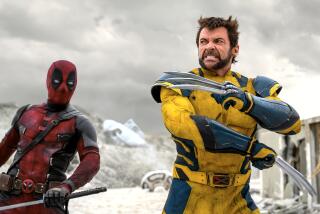Departure Revives Issue of a Brain Drain
- Share via
Gap Inc.’s gain is Walt Disney Co.’s loss, one in a series that has rattled the entertainment company’s executive ranks.
The announcement Thursday that Disney’s theme park chief, Paul Pressler, had signed on as chief executive of the clothing retailer has again raised the issue of a brain drain at Disney.
Executives have quit for a variety of reasons, depleting Disney’s home-grown talent and forcing the company to continually hire executives, leaving the management ranks unsettled. The departures also have contributed to the impression that Disney Chairman and Chief Executive Michael Eisner lacks the ability to hang on to executives.
“The rapid turnover of top executives is almost always a sign of problems,” said USC business professor Warren Bennis.
Pressler is moving on to a more powerful, better-paying position as CEO of Gap Inc.
And sources say there is nothing to suggest that Pressler and Eisner enjoyed anything but a good working relationship. In fact, some considered Pressler an eventual successor.
But the turnover must be recognized as a problem, experts say.
“You need stability to see long-term success,” said David Lewin, a USC business management specialist. “As a business, Disney’s record is quite mediocre,” he said.
Over the years, Disney has seen some of its alumni go on to become some of the biggest names in business.
Former Disney Chief Financial Officer Stephen F. Bollenbach is CEO of Hilton Hotels Corp. Another CFO, Richard Nanula, became CEO of Starwood Hotels & Resorts Worldwide Inc. and now is executive vice president of finance at biotechnology giant Amgen Inc.
Eisner hired former Hollywood agent Michael Ovitz as president, only to push him out within a year. Nickelodeon founding executive Geraldine Laybourne had a slightly longer tenure as head of a unit charged with creating cable television networks.
The company’s film studio has had four chairmen in the last eight years, including Jeffrey Katzenberg, who went on to co-found DreamWorks SKG, and Joe Roth, now chief of Revolution Studios.
This year, after an eight-month search produced no outside candidates, Eisner settled on movie marketing chief Dick Cook for the job.
“You have to have replacements ready to go, and at Disney it’s not clear that they do,” Lewin said.
Perhaps most troubling, the experts said, is the fact that the constant turnover means Disney has not been able to groom a replacement for Eisner, a situation that has disturbed Wall Street.
“By definition, companies with a lot of churn cannot cultivate a successor,” said Richard R. Ellsworth, a corporate culture expert at Claremont Graduate University. “It fundamentally weakens the corporation.”
Katherine Styponias, an analyst with Prudential Securities, said Pressler’s exit would bring Disney’s “revolving-door” problems back into sharp focus among already wary investors.
Perhaps so, said Bill Simon of executive search firm Korn Ferry International. But there isn’t a media company that isn’t hampered by either the depressed market for media properties or the continuing economic recession, he said.
“Disney’s problems only appear somewhat bigger because they’ve fallen so far,” he said.
Replacing Pressler with an executive from outside Disney will be difficult, said Gabriella Colantoni, managing director of executive search firm DHR International. “Paul’s leaving will be a blow. He was well-respected throughout the ranks.”
In cases such as this, Colantoni said, “management needs to acknowledge they’ve got a problem, show candor. It helps.”
*
(BEGIN TEXT OF INFOBOX)
*
High Turnover at Disney
*
In the last eight years, nearly 30 top executives have left the company. A look at a few of the many:
* Steven M. Bornstein, president of ABC Television, quit April 30, 2002.
* Peter Schneider, chairman of Walt Disney Studios, resigned June 20, 2001, to become a Broadway theatrical producer.
* Sanford M. Litvack, Disney vice chairman, announced Oct. 12, 2000, he would resign.
* Judson C. Green, chairman of the theme park and resorts division, quit April 17, 2000, to become CEO of Navigation Technologies.
* Patricia Fili-Krushel, president of ABC Television Network, resigned March 28, 2000, to become CEO of WebMD Health.
* Joe Roth, chairman of Walt Disney Studios, announced his resignation Jan. 12, 2000, to form Revolution Studios.
* John F. Cooke, executive vice president for corporate affairs, announced his resignation Dec. 5, 1999, to become a top executive at the J. Paul Getty Trust.
* Kenneth Wong, president of Disney Imagineering, announced he was quitting Oct. 14, 1999. He became CEO of Pop.com, an Internet entertainment venture, in December 1999.
* Geraldine Laybourne, president of Disney’s cable networks, announced she would leave May 28, 1998, to form her own media company.
* Lawrence P. Murphy, the company’s chief strategist, announced his resignation May 20, 1998.
* Richard Nanula, chief financial officer, announced his resignation April 15, 1998, to become CEO of Starwood Hotels & Resorts Worldwide.
* Dean Valentine, president of Walt Disney Television, quit when he was named CEO of the UPN network Sept. 16, 1997.
* Peter Rummell, chairman of Disney Imagineering, quit Jan. 7, 1997, to become CEO of Florida real estate giant St. Joe Corp.
* Michael Ovitz, Disney president, quit Jan. 31, 1997, with a controversial severance package.
*
Stephen F. Bollenbach, Disney chief financial officer, announced Feb. 2, 1996, he would quit to become CEO of Hilton Hotels.
*
Jeffrey Katzenberg, chairman of Walt Disney Studios, announced his resignation Aug. 24, 1994.
*
Researched by JOHN JACKSON / Los Angeles Times
More to Read
Inside the business of entertainment
The Wide Shot brings you news, analysis and insights on everything from streaming wars to production — and what it all means for the future.
You may occasionally receive promotional content from the Los Angeles Times.










